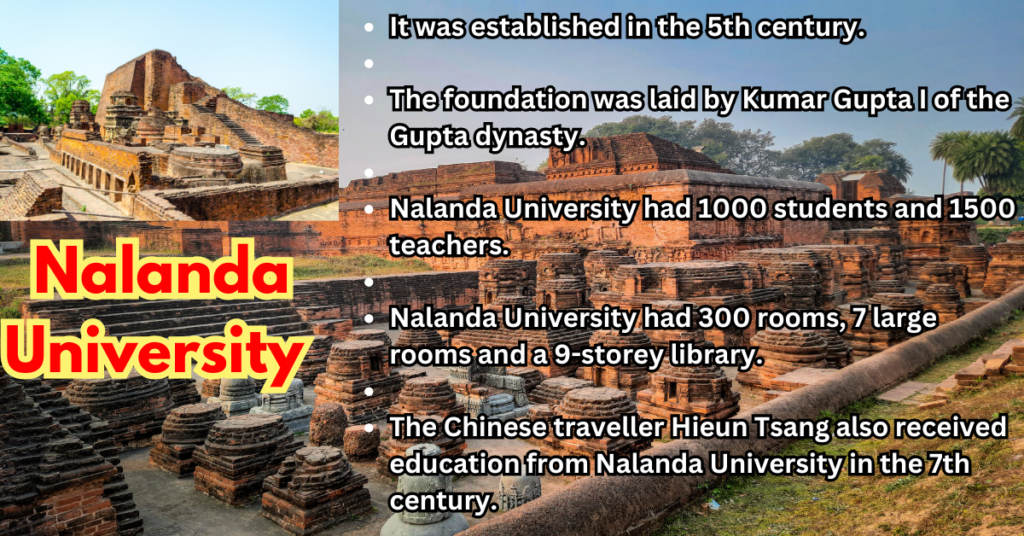
About Nalanda University
It was established in the 5th century.
The foundation was laid by Kumar Gupta I of the Gupta dynasty.
Nalanda University had 1000 students and 1500 teachers.
Nalanda University had 300 rooms, 7 large rooms and a 9-storey library.
The Chinese traveller Hieun Tsang also received education from Nalanda University in the 7th century.
Nalanda University has been called the storehouse of knowledge in the world. Many subjects like religious texts, literature, theology, logic, medicine, philosophy, astronomy were taught in this university. At that time, the subjects which were taught here were not taught anywhere else. For 700 years, this university was the path of knowledge for the world. After a long journey of 700 years, it was burnt down by Bakhtiar Khilji in the 12th century. The middle period is considered to be the 5th century BC.
Establishment
Nalanda University of ancient India was a major and historical educational center. It is the world’s first residential university, where teachers and students live on the same campus. Gupta emperor Kumar Gupta I founded Nalanda University in 450 AD. Harshvardhan and Pal rulers also patronized it later. The grandeur of this university can be gauged from the fact that it had 300 rooms, 7 large chambers, and a huge 9-storey library for study. The library had more than 90 lakh books.
Development
University peaked from the 7th to the 12th century. The most important reason for its development was the high level of knowledge and style of the scholars and teachers there, which was in the streams of Chhayavadi and Mahayana religion. Various subjects were studied here, such as Buddhism, astrology, mathematics, logic, and Vedic scriptures.

The Chinese monk Xuanzang studied at Nalanda
Most of the Buddhist monks who came to study at University were from Asian countries like China, Japan and Korea. According to historians, Chinese monk Xuanzang also studied here in the seventh century. It was one of the two most important centers of Buddhism. This shows the contribution of ancient India in the spread of knowledge and wisdom. Xuanzang has written about the grandeur of Nalanda University in his books.
Why did Khilji burn down the university
Turkish ruler Bakhtiar Khilji, his full name was Ikhtiyaruddin Muhammad bin Bakhtiar Khilji.
According to the historian, once Bakhtiar Khilji fell very ill. His doctors treated him a lot but it was of no use.
It is said there were so many books in the university that the library was on fire for three months.
hen he was advised to get treatment from Acharya Rahul Sribhadraji, the head of the Ayurveda department of Nalanda University.
He called Acharya Rahul and before treatment he put a condition that he would not consume any Indian medicine. Even after that he said that if he did not get well, he would get Acharya killed.
The fire was set in 1199
The next day the Acharya took the Quran to him and said that if he read pages from so and so to so of the Quran, he would get well. He read it and got well. He was not happy, he got very angry that why the knowledge of these Indian Vaidyas was better than his Hakims.
In return for the favor of Buddhism and Ayurveda, he set fire to Nalanda University in 1199.
There were so many books there that even after the fire broke out, the books kept burning for three months. He killed thousands of religious leaders and Buddhist monks.
The reason given for Khilji’s recovery is that Vaidyaraj Rahul Sribhadra had applied an invisible coating of medicine on the corners of some pages of the Quran. He licked only ten to twenty pages with spit and got cured. He repaid this favor by burning Nalanda.
What was the significance of Nalanda University in ancient education?
Nalanda University, established in the 5th century AD by Kumar Gupta I of the Gupta dynasty, was the world’s first residential university, where teachers and students lived on the same campus. It served as a global hub of knowledge for over 700 years, attracting scholars from Asia, including China, Japan, and Korea. With 1,000 students and 1,500 teachers, it offered an unparalleled curriculum that included religious texts, literature, theology, logic, medicine, philosophy, and astronomy. The university’s 9-storey library, housing over 9 million books, and its 300 rooms underscored its grandeur and intellectual legacy.
How did Nalanda University contribute to the spread of Buddhism and other disciplines?
Nalanda University was a pivotal center for Mahayana and Chhayavadi Buddhism, drawing Buddhist monks from across Asia. The Chinese monk Xuanzang, who studied there in the 7th century, documented its splendor in his writings, highlighting its role in disseminating Buddhist philosophy. Beyond religion, it excelled in astrology, mathematics, logic, and Vedic scriptures, offering subjects unmatched elsewhere. This multidisciplinary approach made it a beacon of wisdom, influencing global education and cultural exchange for centuries.
What led to the destruction of Nalanda University by Bakhtiar Khilji?
Nalanda University was destroyed in 1199 by Turkish ruler Bakhtiar Khilji. The incident stemmed from a personal grievance: Khilji, gravely ill, sought treatment from Acharya Rahul Sribhadra, the head of Nalanda’s Ayurveda department. Despite initial reluctance to use Indian medicine, Khilji recovered after following the Acharya’s advice to read specific Quran pages coated with a medicinal layer. Angered by the superiority of Indian knowledge over his own physicians, Khilji retaliated by setting the university ablaze, an act that burned its vast library for three months and killed thousands of monks and scholars.
What was the architectural and academic scale of Nalanda University?
Nalanda University was an architectural marvel, featuring 300 rooms, 7 large chambers, and a monumental 9-storey library. Academically, it peaked from the 7th to 12th centuries, supported by a faculty of 1,500 teachers and a student body of 1,000. Its library contained over 9 million manuscripts, reflecting its status as a storehouse of knowledge. The university’s infrastructure and intellectual resources made it a unique institution, fostering a vibrant community of learning until its tragic end.
How did Nalanda University influence modern education and its revival efforts?
Nalanda’s legacy as a center of multidisciplinary education inspired the establishment of a modern Nalanda University in 2010 near its ancient ruins in Bihar, India, with support from East Asian nations. Its historical emphasis on residential learning, diverse curricula, and international collaboration echoes in contemporary educational models. The ancient university’s destruction in 1199 marked a loss of irreplaceable knowledge, but its revival symbolizes a commitment to reviving its spirit of global scholarship and cultural heritage.